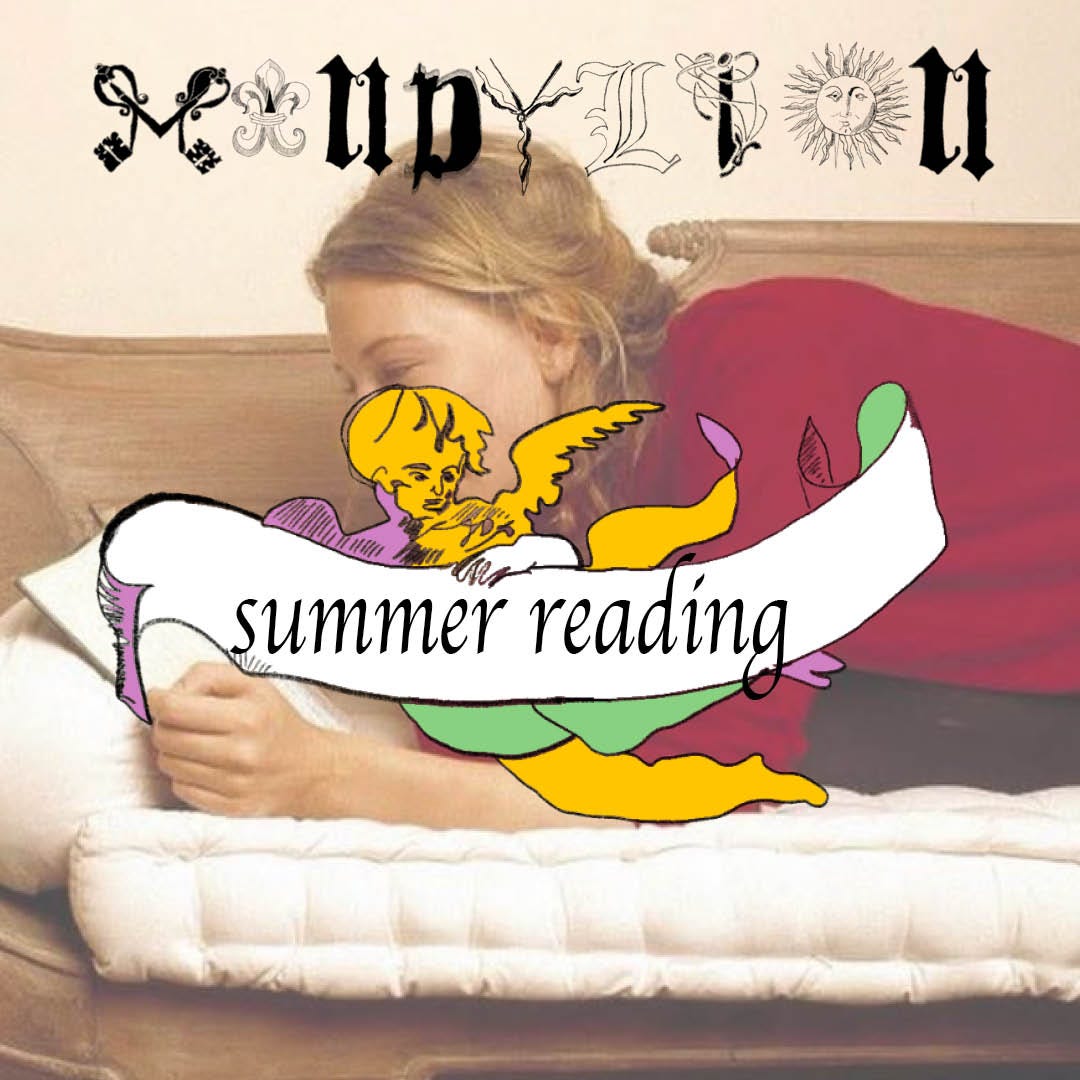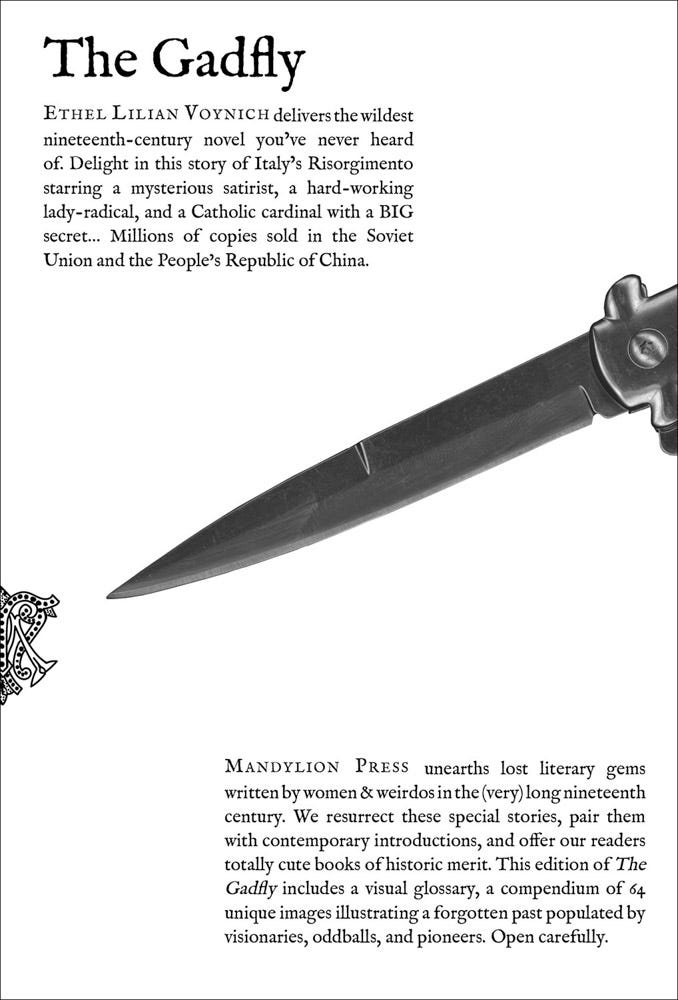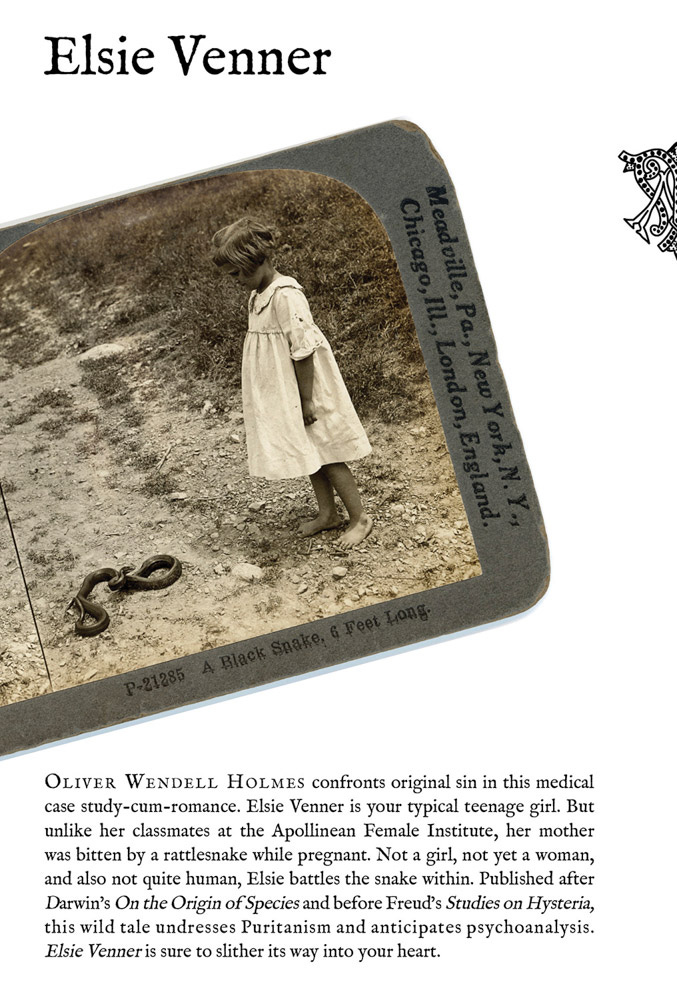Hi everyone!!!!!!!!!!!!! Oh my god you guys look fabulous today :)
June is over and summer is upon us. I love summer because life is agony to me. Yet, in no other season do I suffer so exquisitely as when I am miserable, lightly sunburnt, sitting poolside with a stack of books and bowl of ripe cherries. This is not totally compatible with the fact that Mabel and I now run a business. Because I’m a millennial, I have no choice but to turn my passion for “fawning about” into a passive revenue stream.** So here is a report of my pleasure-reading from Q1 and Q2.
Wait, before I go any further, did you buy a Mandylion t-shirt yet? Or are you willing to accept living a life filled with regret???
January:
The Mill on the Floss by George Eliot (1860)
I love Maggie Tulliver and this book is an amazing portrait of how society tortures clever girls.
Masters of Atlantis by Charles Portis (1985)
Hilarious book about twentieth century occult fraternity fad. Lamar Jimmerson, a soldier lingering in post WWI Europe, meets a refugee who sells him an ancient codex containing the secrets of the Gnomon Society. From there he and two other devotees spread the brotherhood, headquartering their operation in Gary, Indiana. I guffawed, I rarely do that bc it's not ladylike. According to the internet ca. 2020 Michael Cera has optioned it for a movie (needs verification).
February:
David Copperfield by Charles Dickens (1850)
Features possibly the greatest chapter title of all time: “My Aunt Astonishes Me.”
La Bête Humaine by Èmile Zola (1890)
Zola book about trains. Lots of violence and sexual dysfunction, crazy ending. Recommend if you’re into that kind of thing, you sicko.
March:
Little Jewel by Patrick Modiano (2012)
To be perfectly frank, I read this and the Annie Ernaux for a course. People drifting / stream of consciousness isn’t my thing but I preferred the Ernaux if you insist.
Things Seen by Annie Ernaux (2000)
See above.
Much more my speed. It is a work of historical fiction set in fifteenth-century Florence, then just teetering into the Renaissance. The central characters are a bad but charming Greek boy, a beautiful and well-read girl whose father didn’t think she was quite good enough, and the greatest minds of the Italian renaissance. What more could a girl ask for? It is worth noting that in The Hill of Dreams (which Mandylion is releasing in the fall) the main character, Lucian Taylor, dismisses the book, saying that he could easily write a Romola. However, this is more an indication of his hubris than an indictment of Eliot imo.
April:
Our Mutual Friend by Charles Dickens (1865)
Best book of all time. Bizarre multi-plot novel about who is the rightful inheritor of three dust heaps. One of the characters is a man with a peg leg trying to save up enough money to buy back his amputated limb from a taxidermist named Mr. Venus. Another is a doll’s dressmaker. What more must I say?
Around the World in 80 Days by Jules Verne (1872)
Not my favorite.
Tigersprung by Ulrich Lehmann (2000)
You may have noticed that in the introduction to this newsletter, I said “pleasure reading.” Here’s the thing: I’m doing a PhD, it’s my job to read. I read 1000’s of pages in the last six months that are not accounted for on this list. I’ve spared you, assuming most people don’t get PhDs mainly because they would have to read academic books (there’s not much more to it than that). However, Tigersprung is good, fantastic even, if you’re into fashion history, Modernism, nineteenth-century Paris, Walter Benjamin, etc. Lehmann takes fashion seriously as an object of intellectual discourse and uses Benjamin’s metaphor, the Tiger’s Leap (Tigersprung) of fashion, to explain temporal postures that facilitate ever-changing presents and make way for revolutions. Sick.
May:
Creation Lake by Rachel Kushner (2024)
As soon as the semester ended, I treated myself to some contemporary fiction. I enjoyed Kushner’s 2013 novel, The Flame Throwers and the description of Creation Lake was enticing. The thing is… and I mean this in the least obnoxious way possible… I don’t really like most contemporary fiction. This was no exception. Fun but not for me. The narrator was flat and predictable; that may have been the point because it was very much in the genre of “spy novel” but it didn’t make it any more enjoyable to read. The book wanted to play with the conventions of its airport-novel genre by assuming an erudite posture, but it did so without being particularly smart or provocative. All that and no good sex scenes.
The Hearing Trumpet by Leonora Carrington (1974)
A reread for me. I am obsessed with books whose protagonist is an old lady with absolutely no self-awareness. Actually–that’s a genre that contemporary fiction does pretty well. I loved Rivka Galchen’s Everyone Knows Your Mother is a Witch (2021) and Olga Tokarczuk’s Drive Your Plow Over the Bones of the Dead (2009). Angel by Elizabeth Taylor (1957) gets bonus points for also being about a young lady with absolutely no self-awareness--you can hear Mabel and I talk about our love of Angel on Unburied Books. Anyway, this is about The Hearing Trumpet, The Hearing Trumpet is best in class.
The Hill of Dreams by Arthur Machen (1907)
I didn’t really mean for this to be a plug for our next books, but hey! I’m a natural marketing genius. For the last few months I’ve been reviewing manuscripts for our Fall ‘25 releases: The Hill of Dreams, The Gadfly, and, Elsie Vennier. Needless to say they’re all amazing. The Hill of Dreams is a classic story about the decline of a would-be writer’s promising career into a hallucinatory opium-dream. A tale as old as time.
The Gadfly by Ethel Lilian Voynich (1897)
We’re also re-releasing The Gadfly from our first drop of books. A steamy romance set against the backdrop of revolutionary Italy, extremely popular in the Soviet Union but largely forgotten in the US <3
June:
Elsie Venner by Oliver Wendell Holmes Sr. (1861)
A “medicated novel” about a girl whose mother was bitten by a rattlesnake while pregnant, leaving those around her to wonder if she’s evil or just a teenage girl.
On the Calculation of Volume I by Slovej Balle (2025)
It seemed like everyone was reading this book so I felt that I must. I liked it, it’s about a woman who is stuck living the same day over and over. It’s kind of a divorce novel even though it’s not. I’ll keep going, I’m curious to see how Balle sustains the story for seven volumes.
Au Bonheur des Dames by Émile Zola (1883)
Another reread for me. Zola’s novel about the invention of the department store. A personal fave for the descriptions of shoplifting marchionesses and the depiction of Baron Haussmann as a good ol’ boy.
Free Love: The Story of a Great American Scandal by Robert Shaplen (1953–McNally Editions put out a new edition this year)
Fun! Detailed retelling of the scandalous affair between preacher Henry Ward Beecher and Elizabeth Tilton, the wife of his good friend, that shook mid-nineteenth-century America to its core. Definitely reads like it was a New Yorker story in the 50s (it was!)
Currently Reading:
Middlemarch by George Eliot (1871)
I shouldn’t admit that I haven’t read this in full but I am halfway through and it's SO GOOD that I slowed down so I wouldn’t finish it too fast. We love an unassuming queen with architectural ambitions. We love boring husbands. We love extra-marital love.
The Magic Mountain by Thomas Mann (1924)
I’ve been reading this book since last summer, I love it and I think Hans Castorp is the freak of all time. I desperately need an extended stay at a sanatorium in the Alps. Perhaps then I could finish it.
Up Next:
I’m itching to get to a pile of books I picked up at my favorite used book store in the Hudson Valley. Unfortunately, I can’t disclose the name of the store or its location because it would ruin my life if people knew about it. Maybe if this was a paid newsletter… Anywho, this trip I left with a banker’s box full of amazing books for under $50. Because we’ve had a pretty brisk, grey, drizzly British-ish spring, I’ve been wanting books that take place on country estates in the UK. I mostly stuck to the assignment. Here’s what I got:
– Dancing Bear by James Crumley (1983)
About a hard-partying detective who works at Haliburton…
– The Rising Tide (1938) and Queen Lear (1989) by Molly Keane (these appear to be out of print but you can find them on abebooks)
Both seem to be classic Keane books about big houses in Ireland. Queen Lear’s cover copy is amazing:
Eight-year-old Nicandra is named after a horse. She lives with her parents. Sir Dermot and Lady Forester, and her aunt Mrs. Fox-Collier (Aunt Tossie) at Deer Forest. An Irish country mansion, and loves to love and be loved. One day as she prattles about the grounds visting Lizzie the housemaid, Twomey the butler, Mrs. Geary the cook and all the underlings, this delightful structure of life is struck as if by lightning: her mother has committed an act too dreadful ever to be spoken of and vanishes forever from Deer Forest. Nicandra grows up cooing with the dogs, sleeping in Belgian lace, teasing the retarded peasant boy, Silly-Willie, and yearning to love and to give. Frayed memories of her mother's perfume and a missing stableman vaguely disturb her. When the dandy, Andrew catches her eye, Nicandra, beautiful, rich and badly dressed, marries him. Queen Lear tells the story of this frightful marriage and a world that has passed into oblivion.
Sold.
– A volume with three Barbara Pym novels
I can’t remember which three and I really don’t feel like going upstairs to look but I think we all get the vibe.
– Cordelli’s Mandolin by Louis de Bernières (1994)
This seems like it was really big and well-reviewed when it came out and then kind of dropped off (or it didn’t? Am I being ignorant?) which is something that fascinates me. Story has something to do with World War II and a boat.
Artist biographies are great beach reading, escapism at its finest.
I think this one was more popular than Jane Eyre in its day.
– Paul Cézanne’s Letters in German
I have to pass the German reading exam in September or I go to PhD jail so I’m going to practice by reading Cezanne’s letters to Zola in German for some reason.
– The Shutter of Snow by Emily Holmes Colman (1930)
I picked it up because it was a Virago Classics edition and I trust them (good tip if you’re overwhelmed in a used book store is to stick to a publisher you like–actually this advice might be worth a whole newsletter, huh?). About post-partum psychosis.
– The Last Samurai by Helen DeWitt
People love this book, right? That’s all I know about it.
–Rebecca by Daphne Du Maurier (1938)
As previously stated, “Get thee to Manderley” is very much my energy this summer.
The Judgement of Paris by Ross King (2006)
I love reading popular history about the things I study. Do other historians do this? LMK.
I also went to visit our books at Mcnally Jackson where I picked up Sexing the Cherry by Jeanette Winterson and Radio Treason by Rebecca West. I adored Winterson’s previous novel The Passion, which has a hilarious depiction of Napoleon, and am excited to read more. Radio Treason called to me because I love Penelope Fitzgerald’s novel, Human Voices, about the BBC radio during WWII. Maybe they have nothing in common, we shall see…
And finally, I went to Greenlight Books and bought a new translation of J.K. Huysmans’ Domesticity put out by Wakefield Press, a small press doing new translations of early modernist literature whom we simply love and adore.
So that should get me through 2030 books-wise.
Okey dokey dear, that’s all for now.
As ever,
Madeline
**on that note this is the first time we are using affiliate links so if you buy something through this newsletter, you’re doing no less than supporting our dreams of creating the biggest small press the world has ever seen. ;*

















I love lists like this! Some favorites and many new to me. Forever adding to my tbr. Excited to see the new Mandylion editions and can’t wait to get my hands on The Gadfly reissue! ❤️
I'm sold on Queen Lear too after reading that cover copy! Wowzers lol.
Great issue of your newsletter. :)